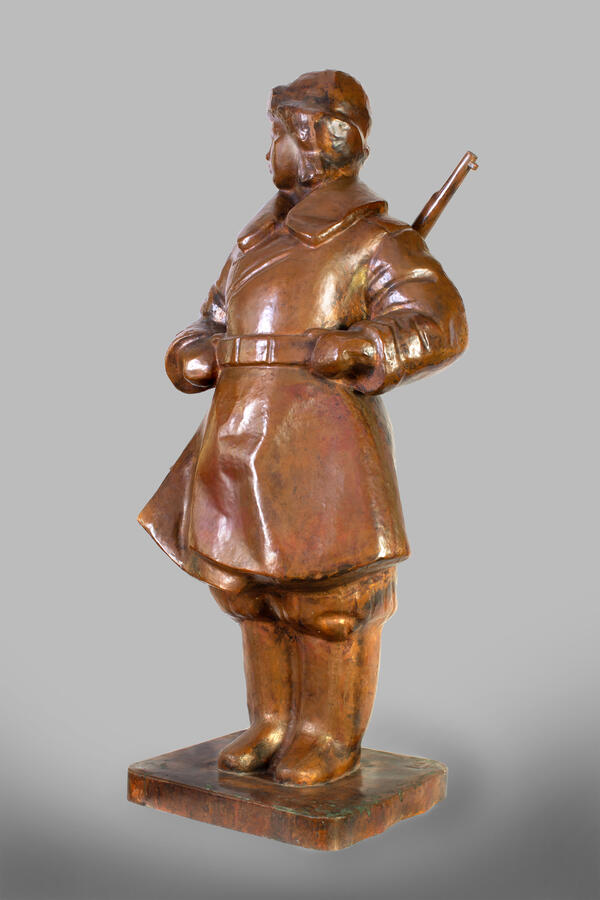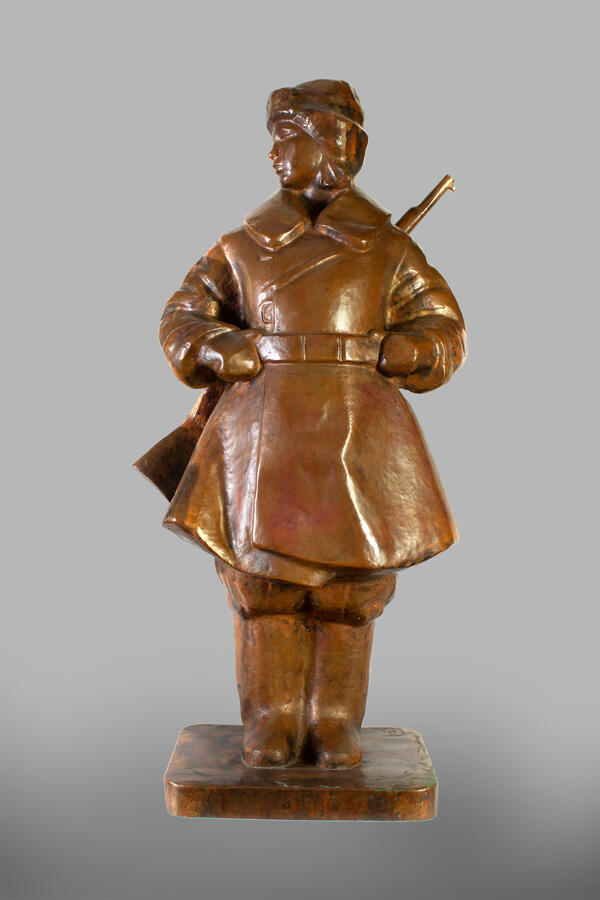The collection of the Tambov Regional Art Gallery houses a forged copper sculpture named “The Defender of Moscow” made by the famous Tambov sculptor Tatyana Georgiyevna Welzen (1930–1968).
The works made by Welzen are diverse in both genre and technique. She mastered monumental sculpture and portraiture, small-scale sculpture and compositions, hammered silverwork, and bone carving. Her works made even the most mundane motif sound deeply lyrical.
A new important facet in the nature of the young heroine was revealed by the sculptor in her work “The Defender of Moscow” (1967). The figure of a girl in a soldier’s sheepskin coat, with a carbine over her shoulders, is imbued with calmness and courageous determination. The generalized forms of the sculpture made of forged copper with a dull metal surface, make the work look somewhat restrained, which fits the harsh wartime realities. This accurately chosen background serves as one of the important means that reveal the specifics of the time, making the image profoundly true-to-life. In fact, the image created by Welzen in “The Defender of Moscow” is of a generalized nature, as it absorbed the best qualities of women — the heroines of the Great Patriotic War.
The Battle of Moscow was one of the most important events during the Great Patriotic War. It began on September 30, 1941, and lasted until April 20, 1942. The military parade that took place on Red Square in Moscow on November 7, 1941, played an important role in raising the morale of the defenders of the capital. The Battle of Moscow was Germany’s first strategic defeat in World War II. It dispelled the myth of the invincibility of the German Nazi military machine and contributed to the strengthening of the anti-Hitler coalition and the weakening of the bloc of fascist states. As a result of the failure of the fascist troops, the political establishment of Japan and Turkey abandoned the idea of entering the war against the USSR. Besides, the victory of the Red Army in the Battle of Moscow intensified the liberation movement among the peoples of Nazi-occupied Europe against fascist enslavement.
The works made by Welzen are diverse in both genre and technique. She mastered monumental sculpture and portraiture, small-scale sculpture and compositions, hammered silverwork, and bone carving. Her works made even the most mundane motif sound deeply lyrical.
A new important facet in the nature of the young heroine was revealed by the sculptor in her work “The Defender of Moscow” (1967). The figure of a girl in a soldier’s sheepskin coat, with a carbine over her shoulders, is imbued with calmness and courageous determination. The generalized forms of the sculpture made of forged copper with a dull metal surface, make the work look somewhat restrained, which fits the harsh wartime realities. This accurately chosen background serves as one of the important means that reveal the specifics of the time, making the image profoundly true-to-life. In fact, the image created by Welzen in “The Defender of Moscow” is of a generalized nature, as it absorbed the best qualities of women — the heroines of the Great Patriotic War.
The Battle of Moscow was one of the most important events during the Great Patriotic War. It began on September 30, 1941, and lasted until April 20, 1942. The military parade that took place on Red Square in Moscow on November 7, 1941, played an important role in raising the morale of the defenders of the capital. The Battle of Moscow was Germany’s first strategic defeat in World War II. It dispelled the myth of the invincibility of the German Nazi military machine and contributed to the strengthening of the anti-Hitler coalition and the weakening of the bloc of fascist states. As a result of the failure of the fascist troops, the political establishment of Japan and Turkey abandoned the idea of entering the war against the USSR. Besides, the victory of the Red Army in the Battle of Moscow intensified the liberation movement among the peoples of Nazi-occupied Europe against fascist enslavement.







